[No, no, no, no apologies for including more than one campaign scenario in this issue. This is a period I have never tried but having read Paul's article, I must say, I am very tempted to find someone with the appropriate troops - my rheumy old eyes refuse to allow me to paint to anything like the standard I want, so I get very "old gitty" when I try! Ed]
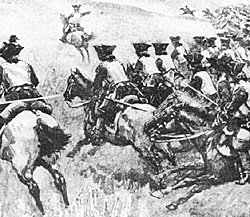 Heavy cavalry, (cuirassiers), charging. Marlboroughs major two victorys at Blenheim and Malplaquot wore won as a result of using cavalry this way.
Heavy cavalry, (cuirassiers), charging. Marlboroughs major two victorys at Blenheim and Malplaquot wore won as a result of using cavalry this way.
My good friend, Rob Le Vesconte, has been working enthusiastically to develop a wargaming group under the umbrella of Saruman's Comic Book Cafe here in Jersey. He has long been keen to become involved in Marlburian warfare and recently turned up with one of Irregular Miniatures Marlburian Army packs painted in British colours; to his usual immaculate standard.
Dissatisfied with the commercial rule sets available he sat down to write his own set of tactical rules drawing heavily upon such proponents of the simple wargame as Brother Alfred Glidden who has a regular column in MWAN. The question of army lists was charmingly solved by declaring that the composition of the Irregular Miniature Army packs would dictate the number and type of units available.
Each player would be allowed two Army packs maximum. It was necessary to slightly amend the composition of the packs to avoid straying too far from historical reality but the idea proved very popular at the cafC, and soon paint was flying in all directions. (An army pack consists of approximately eight infantry units, four cavalry units, two batteries of artillery, [two models in each] and four Generals).
In the case of the French pack they supply a Hussar unit and as there were only two Hussar regiments in the French Army at the time we allow the replacement of this with another cavalry unit. There is also a unit of Grenadiers in mitres, the French Grenadiers wore tricornes like the rest of the infantry so we sometimes use these as dismounted dragoons or allow their replacement with another foot unit.) Rob very generously gave up a lot of his spare time to demonstrate various painting techniques and some of the players soon produced very creditable results.
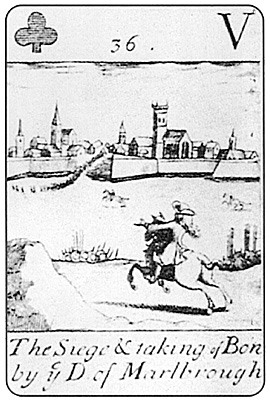 Queen Anne playing card from set by J Spofforth to commemorate War of Spanish Succession
Queen Anne playing card from set by J Spofforth to commemorate War of Spanish Succession
A number of games were held to play-test the rules and it was found that a game between two players could be fought within three hours on a table four feet by three feet. Bigger battles between a larger number of players soon bogged down and lasted for ages as large games are wont to do. After a while the players decided that they wanted to take part in a campaign and a set of rules was required. I present these below for your entertainment. if you decide to give them a go, feel free to alter anything that does not suit you or your rules system.
To understand these rules it is necessary to be told that Rob's rules provide for each unit (battalion, battery or squadron) to have 2 cohesion points which, once lost, result in rout offboard. Each player may designate one elite unit which receives an extra cohesion point.
CAMPAIGN RULES
The object of this campaign is to provide a background to a series of Battles with Marlburian Armies during the war of the Spanish Succession..
1. Start Procedure:
The Allies, consisting of the British, Dutch, Austrians and German States, will elect a Commander from amongst themselves with each Player having one vote. This simulates the democratic processes that hampered Marlborough's plans.
The French and their allies, only Bavaria if any, will decide amongst themselves which Player has lost the least Battles. This person will become the Commander until he loses an engagement when he will hand-over to the next most successful Player. This simulates Louis XlVth's personal interest in the progress of the war.
2. Deployment:
Each commander will tell each of his Players where they will start from. British troops start in Britain; Dutch and French in one of their five starting fortresses set within the start areas marked on the map; other troops start in a fortress located in their own start area. The remaining fortresses are considered occupied by neutral garrisons or can be occupied by extra players.
If either course of action offends then treat them as towns, (the defences are obviously in disrepair). The commander will also at this time issue orders. The Allied Players should then vote on whether to accept these orders and may agree an alternative course of action. If there is more than one suggested plan then a vote should be taken with each Player having one vote. The Commander has a casting vote in the event of a tie.
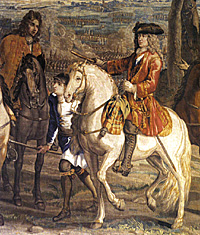 Blenheim Palace's 'Hdchstildt' tapestry depicting Marlborough in his prime. (de Vos after L de Hondt)
Blenheim Palace's 'Hdchstildt' tapestry depicting Marlborough in his prime. (de Vos after L de Hondt)
Each Player may deploy his troops as follows:
1 Army Pack minimum per space, (An Army)
Exceptions:
- a. Each Player may deploy 1 cavalry patrol per Army Pack up to 1 march move away.
b. Detachments in multiples of 4 units may be left as garrisons at fortresses under the command of 1 general figure for every 4 units. These detachments may not take any form of offensive action and may only move to rejoin the main army.
c. The British may supply by sea and can therefore deploy in Britain, at a port on the continent or within one space of a port and still counting as being in supply.
d. The Commanders must deploy one supply depot for their side. This represents the remounts, wagons, supplies, engineers, medical supplies and camp-followers which are vital to the ability of each side to conduct extended operations in the field. Once destroyed it may not be rebuilt in the same campaign year.
3. Commander's Tasks:
At the start of the game each Commander should record on the map and on the campaign log the whereabouts of all his troops. This will take the form of a coloured pin or other indicator which will not only tell the enemy the location of troops and not what is present.
Fortresses owned at the start of the game or subsequently captured are also marked as this signifies the pres- ence of garrison artillery units. The Commander will also be responsible for the march orders for the supply depot.
4. March Moves:
A march move is the distance between the currently occupied location and an adjacent one connected by a movement line. British only, count movement between Britain and the continent as a march move. A turn is one week and there are four to each month from April to September inclusive. Each turn the Players will give their march orders to their Commander. Failure to submit these orders in time will result in the troops remaining at their current location unless they are out of supply in which case they will move back to the nearest friendly fortress in supply, or, optionally, port if Allied. The movement orders must be sufficiently clear for the Commander to be able to understand them. If a unit is unsupplied then its only allowable move is to attempt to get back into supply this turn.
5. Communications:
Players may only talk in detail about the campaign with their colleagues if their Armies occupy the same location. All other communication should be by written message which is deemed to be taken by courier. A courier can move up to three march moves per turn and can pass through enemy units.
6. Supply:
In order to count as being in supply an Army must be able to trace a line of supply free of enemy units, (Enemy garrisons count but enemy fortresses withowt additional troops don't), to the supply depot which must itself be connected to a friendly fortress or to a friendly port if Allies. Even besieged enemy units interrupt supply.
Any friendly fortresses or units in friendly fortress-', es are always in supply. The length of,: any supply line may not be greater than 2 march moves. The effects of being un-supplied for movement purposes are set out in 4 above. If an Army is brought to battle whilst un-supplied then all of its units will count as starting the battle at 1 cp less than normal. Cavalry patrols are never out of supply. It is not possible to trace a line of supply across a road junction where enemy forces are present.
7. When forces meet:
The consequences of opposing forces meeting depends on what the type of units are as follows:
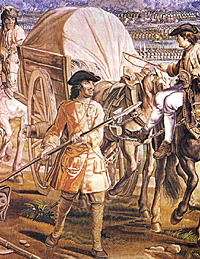 Blenheim Palace tapestry depicting the Battle of Wynendael, September 1708. The wagon would have been used to carry weaponry and light munitions. The use of these more mobile, 2 horse, 2 wheeled wagons was at the insistence of Marlborough whilst he was Master-General of the Ordnance. (de Vos after L de Hondt)
Blenheim Palace tapestry depicting the Battle of Wynendael, September 1708. The wagon would have been used to carry weaponry and light munitions. The use of these more mobile, 2 horse, 2 wheeled wagons was at the insistence of Marlborough whilst he was Master-General of the Ordnance. (de Vos after L de Hondt)
a. If one side is only a cavalry patrol then it will withdraw to its parent unit but the opponent must declare, ( only to the enemy player whose cavalry patrol it was), the number of Infantry lions, Cavalry Regiments and artillery Batteries present in his force.
b. If both sides are cavalry patrols then each Player throws 1D6. Highest wins, re-throw draws, loser must disband his patrol and cannot form a new one until the next turn. The winner may request details from the enemy Player about one adjacent location. The Player must respond as above.
c. If both are Field Armies and the meeting is at a non-fortress location or if both Armies are advancing along the same road then each Player must reveal the approximate strength of his force, ie. "1 Army Corp", (1 army pack), or " 1 and 1/2 Army packs" etc. Each side must then Choose secretly to fight or withdraw.,
d. If a moving Field Army contacts a nonmoving force and has advanced across a river this go then the nonmover can either let the attacker cross or can dispute the crossing. If crossing is disputed treat the same as siege but without modifiers for garrisons or losses. See below for procedure. Both sides then choose to fight or withdraw as above.
e. If one side is in a fortress 'it may choose whether to leave to fight a battle or to stand a siege.
8. Battle:
After both sides have chosen their options for battle, simultaneously reveal decisions. 'If both withdraw there is no battle and both sides go back to the positions they occupied at the start of the turn. Exception, units that have advanced this turn to a friendly fortress where enemy units are present, (preumably besieging), may withdraw into Fortress.
If one fights and the other withdraws then the side, withdrawing moves back to its last location. In this case a force may not withdraw into a besieged fortress at the same location. The side choosing to fight may occupy the loca~tion or, if on road, may continue to the next location. This continuing of the move may result in another battle possibility.
It is possible for a force to be caught on a road between two enemy forces. If the trapped force cannot fight their way Out then they must surrender to the enemy. When this happens the senior Player of the surrendering force is deemed to be imprisoned in the enemy capital and he and his forces take no further part in t ' he campaign. If there is more than, one Player then only the senior one is removed from play, any others are deemed to be exchanged and re-start from a fortress in their country's start area.
If both sides elect to fight, a battle takes place using all normal tactical rules currently in use. There should be a time limit set, (we use sixteen turns). If there is more than 1 Player per side then a Commander must be chosen by each side, (see rules about choosing commanders above). The Commander will then allocate each player a section of the battlefield.
The available sections are, Left Wing, Right Wing, Centre and Reserve. There can only be one Player per section from each side and a force must be at least five units strong to take the field. An Army comprising two Army packs belonging to two different Players is under the command of only one of them decided in accordance with the procedure set out in 1. above. Both sides then reveal their dispositions and the battle will then be resolved by a series of one-to-one games starting in the following order:
- Right Wing (of attacking
army)
Left Wing
Centre
A Commander may, after dispositions are revealed, move a player from the Reserve to a vacant position in his battle deployment. If there is no enemy player opposite you and no enemy player is without an opponent then there is no battle. Each section won by victory in battle or by default counts as 1 point towards deciding the overall winning side of the battle. The winner gains the location or can continue moving towards it's intended destination.
This may cause a further battle depending on the options chosen by each Commander. (See surrender rules above if a force is trapped between two enemy forces and cannot fight its way out.) If the battle is drawn, (even if this is not possible under the tactical rules it is likely that two armies could face each other without taking any offensive action ), then both sides remain at the location and choose options again next turn. Exception: If the meeting was an encounter during a march move then both sides withdraw to their starting locations.
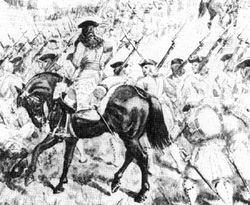 Derby's Regiment, advances on the Village of Blenheim as part of Cutt's left wing. (R Simkins)
Derby's Regiment, advances on the Village of Blenheim as part of Cutt's left wing. (R Simkins)
(It may be possible under other rule sets to fight multi-player battles without utilising the above procedure which is, admittedly, somewhat artificial).
After a battle all cp losses are totalled for each side, each player will then immediately be able to regain half,( rounding up), of his losses and can allot these to any unit that suffered loss during the preceding battle but which was not destroyed by being contacted in rout. He may also build one unit up to 3 cps in effect creating new veteran units. Only one unit can be built or re-built to 3 cps at this time. The Commander of each Army must be informed of the amount of losses. He will then allot the remaining half to the replacement pool which is maintained at the supply depot. Any units completely destroyed do not contribute any cp points to either the Player or to the Supply Depot.
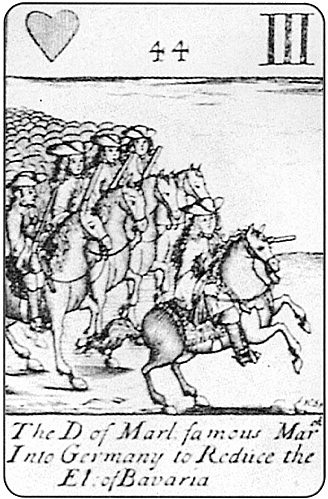 Queen Anne playing card from set by J Spofforth to commemorate War of Spanish Succession.
Queen Anne playing card from set by J Spofforth to commemorate War of Spanish Succession.
After missing one turn they are again available at any fortress in the start area of the country they belong to. They must then march to the supply depot before they can be re-formed. If they are contacted by enemy forces, ( including cavalry patrols ), and they are alone then they are dispersed and must start over.
If one side has decided to stay or to withdraw into a fortress then an attacker with fightorders may declare a siege or an assault. Sieges are the process whereby a besieging army stays at a location to build up modifiers to help in an assault against enemy forces defending a fortress at the same location. In order to conduct a successful assault a Player must throw 6 on 1D6 at the end of a campaign turn. For each spot of the dice less than 6 the attacker loses a unit. This counts as destroyed, see rebuilding rules above. The dice throw modifiers are as follows:
- +1 for each turn after the first
spent at the fortress
- 1 for each enemy general present with the defenders (One per 4 Units)
The first successful assault will only carry the outer works of the fortress, the attacker must immediately offer the garrison the Honours of War. If accepted the defenders will be allowed a free march move to the nearest friendly or vacant location. If the defenders choose to fight on then assault procedure must begin all over again but with a +2 starting modifier, (the defenders are assumed to have withdrawn inside the citadel or castle keep). The second time an assault is successful every member of the garrison is killed. This means that all defending units are lost. If the siege is interrupted by the need to form up to offer battle to a relieving enemy army the modifier stays the same until the siege is resumed. It is possible to screen some besieging forces thus allowing the siege to continue but this may allow enemy defending units the opportunity to decide to emerge and fight a battle.
10. Replacements:
The cps stored in the replacement pool may be taken to replace losses by units visiting the supply depot with the authority of the Commander. Units completely destroyed must be rebuilt as above. Note: the supply depot does not have any defensive or offensive capacity and therefore is destroyed if contacted by the enemy, (not including cavalry patrols).
11. Victory Conditions:
The Allies win if they manage to combine their armies and are in possession of one of the French starting fortresses by the end of the game.
The French win if they are in possession of one of the Dutch starting fortresses at the end of the game and have managed to prevent the Allied armies combining or have defeated the combined army in battle.
Anything else is a draw.
12. Retirement of Players:
If a Player retires from the campaign his troops are deemed to become a Garrison at the nearest friendly fortress but do not contribute to the defence.
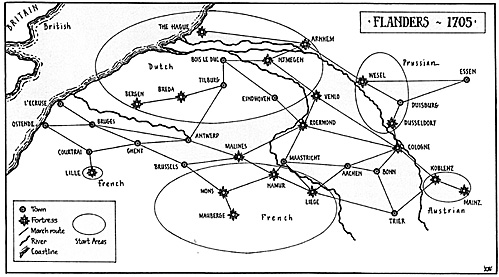
Back to Battlefields Vol. 1 Issue 7 Table of Contents
Back to Battlefields List of Issues
Back to Master Magazine List
© Copyright 1999 by Partizan Press.
This article appears in MagWeb (Magazine Web) on the Internet World Wide Web.
Other military history articles and gaming articles are available at http://www.magweb.com